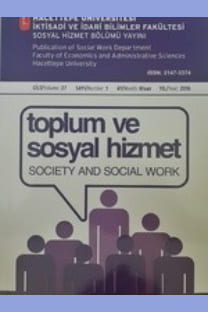1900-2000 YILLARI ARASINDA AVUSTURYA’DA ENGELLİLERE YÖNELİK SOSYAL POLİTİKA VE SOSYAL HİZMETLER: MEDİKAL MODELDEN SOSYAL MODELE GEÇİŞ
Modernizasyon süreci içinde engelliliğe yaklaşım, üç modelde sınıflandırılabilir, medikal model, sosyal model ve post-modern/ azınlık modeli. Bunların içinde hak temeli olması ve sosyal bakıma odaklanması açısından,en çok kabul gören sosyal modeldir.Bu makalenin amacı, gelişmiş bir refah devleti olan Avusturya üzerinden, engelliliğe ilişkin politikaların medikal modelden, sosyal modele doğru evrilmesini incelemek ve özellikle 1990-2000 arasında uygulanan sosyal modelin içeriğine dair somut örnekler sergilemektir.
Anahtar Kelimeler:
Avusturya, engelliler, sosyal politika, sosyal hizmet
Social Policy and Social Services Concerning Disabled People in Austria Between 1900-2000: From Medical Model to Social Model
Modernapproachestowardsdisablitycanbe classified under three models: medical model, social model and postmodern/minority model. In the contemporary era social model is the most accepted one, since it is based on human rights and focused on social care. The aim of this study is to investigate the evolution of disability policies from the medical to the social model,and suggest concrete examples of implementation of social model with in the example of Austria, which is a strong welfare state.
Keywords:
Austria, disability, social policy, social services,
___
- Alber, J. (1982). Vom Armenhaus zum Wohlfarhtstaat. Analysen zur Entwicklung der Sozialversicherung in Westeuropa. Frankfurt: Campus.
- Atasü-Topcuoglu, R. ve Akbaş, E. (2009). Küreselleşme Sürecinde Daralan Sosyal Haklar ve Türkiye’de Sosyal Hizmet Sunumunda Yaşanan Dönüşümün Kuramsal ve Politik Çerçevesi, Uluslararası Sosyal Haklar Sempozyumu Bildiri Kitabı, Antalya: Akdeniz Üniversitesi Yayını.
- Arıkan, Ç. (2002). Sosyal Model Çerçevesinde Özürlülüğe Yaklaşım, Ufkun Ötesi, 2(1): 10-16
- BMASK (Bundes Ministerium für Arbeit, Sozial und Konsumerschutz) (1993). Das Behinderten Konzept der Österreicheschen Bundesregierung, Wien: Bundesministerium für Arbeit und Soziales in Zusammenarbeit mit der Österreichischen Arbeitsgemeinschaft für Rehabilitation
- BMASK (Bundes Ministerium für Arbeit, Sozial und Konsumerschutz) (2009). Bundesweites arbeitsmarktpolitisches Behindertenprogramm BABE 2010-2011, Wien: BMASK.
- Brennan, M. A., ve Conroy, P. (2004). The Three present Target for the Employment of People with Disabilities in the Public Service. Delivering Change Through Disability Research 3rd Annual NDA Disability Research Conference Proceedings Book (ss. 123-138), 19 Ekim 2004, Dublin: National Disability Authority (NDA).
- Buchner, T. (2009). Deinstitutionalisation and community living for people with intellectual disabilities in Austria: history, policies, implementation and research. Tizard Learning Disability Review, 14(1), 4-13.
- Çağlayan, D. (2006). Özürlü Haklarının Gelişimi: Merhametten Hakka, Ankara: TODAIE Yayınları
- Diebäcker, M., Ranftler, J., Strahner, T., ve Wolfgruber, G. (2009). Neoliberale Strategien und die Regulierung sozialer Organisationen im lokalen Staat. Von der Ökonomisierung des Politischen zur Depolitisierung und Deprofessionalisierung der Sozialen Arbeit. soziales_kapital, 3(1). Internet kaynağı: http://www.sozialeskapital.at/index. php/sozialeskapital/article/view/150/212, son erişim: 31.07.2014
- Esping-Andersen, G. (1990). The Three Worlds of Welfare Capitalism, Princeton: Princeton University Press.
- Gökmen, F. (2007). Türkiye’de Özürlü Haklarının Gelişimi, Özveri, 4(2):1085-1106.
- Grandl, R. (tarihsiz). Seit 120 Jahren: Die Geschichte der Selbstverwaltung von den Arbeiterkrankenkassen des 19. Jahrhunderts bis zum Hauptverband der österreichischen Sozialversicherungstraeger. Internet kaynağı: www.arbeıtwirts chaft.at son erişim:12/06/2014
- Hammer, E., ve Österle, A. (2001). Neoliberale Gouvernementalität im österreichischen Wohlfahrtsstaat. Kurswechsel, 4, 60-69.
- Jahoda, A. ve Markova, I. (2004). Coping with social stigma: people with intellectual disabilities moving from institutions and family home, Journal of Intellectual Disability Research, 48(8):719-729.
- Karataş, K. (2002). Özürlülere Yönelik Ayrımcılık ve Ayrımcılıkla Savaşım, Ufkun Ötesi Bilim Dergisi, 2(1): 1-10.
- Klicpera, C., ve Gasteiger-Klicpera, B. (2002). Wohnen und Leben von Menschen mit einer Behinderung in Österreich. Gegenwärtige Situation und Perspekti- ven., içinde: Evangelisches Diakoniewerk Gallneukirchen (Der.) : Vom Machen und Ermöglichen. Lebensvielfalt als Herausforderung (ss.23 – 27). Gallneukirchen: Evangelische Diakoniewerk.
- Lang, R. (2001). The development and critique of the social model of disability, London: Leonard Cheshire Disability and Inclusive Development Centre.
- Mackelprang, R.W. ve Salsgiver, O.S. (1996). People with Disabilities and Social Work: Historical and Contemporary Issues, Social Work, 41(1): 7-14.
- Morris, J. (2001). Social exclusion and young disabled people with high levels of support needs, Critical Social Policy, 21(2): 161–183.
- Naue, C. (2006). Governing Disability in Austria: Reflections on a Changing Political Field, Disability Studies Quarterly, 26(2).
- Neues Wiener Tagblatt, (13/11/1915). Das Erste Stiftunghaus für die Kriegerheimtättenanlage, Neues Wiener Tages Blatt, [gazete haberi] Internet kaynağı: http://www.digital.wienbibliothek.at/ wk/periodical/zoom/669098 son erişim: 14/06/2014
- Obringer, H. (2002). Föderalismus und wohlfahrtstaatliche Entwicklung: Österreıch und die Schweiz im Vergleich, Politische Vierteljahresschrift, 43(2): 235-271.
- Rosanvallon, P. (2004). Refah Devletinin Krizi, Dost Kitabevi Yayınları, Ankara.
- Shakespeare, T. (2006). Disability rights and wrongs, New York:Routledge.
- Swain, J., Finkelstein, V., French, S. ve Oliver, M. (1993). Disabling barriers, enabling environments. London: Sage.
- Talos, E. (2001). Sozialstaat Österreich, WISO, 4: 15-25.
- Talos, E. (2004). Umbau des Sozialstaats? Österreich und Deutschland im Vergleich, Politische Vierteljahresschrift, 45(2): 213-236.
- Weber, M. (1905/1992). The Protestant Ethic and the Spirit of Capitalism. (Talcott Parsons çev.) Londra: Routledge.
- ISSN: 2147-3374
- Yayın Aralığı: Yılda 4 Sayı
- Başlangıç: 2000
- Yayıncı: Hacettepe Üniversitesi İktisadi ve İdari Bilimler Fakültesi
Sayıdaki Diğer Makaleler
SOSYAL HİZMET İMAJI: ÖĞRENCİLERİN ÇALIŞMA ORTAMLARINA VE MESLEKİ POZİSYONLARA YÖNELİK İLGİLERİ
Veli DUYAN, Ayşe Sezen SERPEN, Rumeysa AKGÜN
EŞİNE ŞİDDET UYGULAYAN ERKEKLERİN EVLİLİK YAŞANTILARI VE ŞİDDET
YETİ YİTİMLİ BİREYLERİ SAKATLAYAN KENTSEL MEKÂNLAR
Cemile ÇETİN, Nurgül BAĞCI KURT
SOSYAL HİZMETİN DİYALEKTİĞİ: SOSYAL HİZMETE DAİR ELEŞTİREL ÇIKARIMLAR
Yaşlılık ve Sosyal Hizmet: Yaşam Destek Merkezi
NIKLAS LUHMANN’IN SİSTEM TEORİSİ VE TEORİNİN SOSYAL HİZMET DİSİPLİNİNDEKİ YANSIMALARI
Özlem CANKURTARAN ÖNTAŞ, Sinan AKÇAY
BİR GRUP YAŞLI BİREY ÜZERİNDE THUNDER BAY ÖLÇEĞİ’NİN GEÇERLİK VE GÜVENİRLİK ÇALIŞMASI
